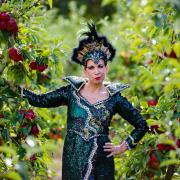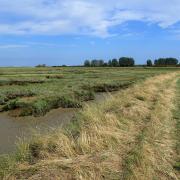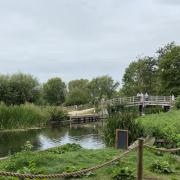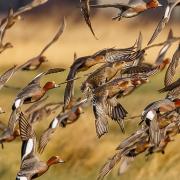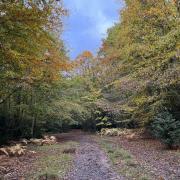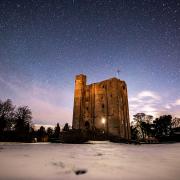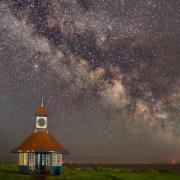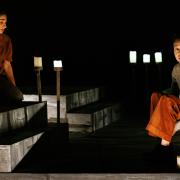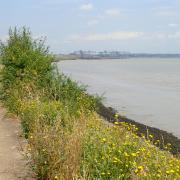You can’t venture further north in Essex than these two quiet, rural parishes nestled in the Stour valley, overlooking Suffolk
The Walk
1. Take the path at the rear of the car park and fork left at the waymarker (N.B. if the nature reserve is flooded then instead just walk the lane between points 1 and 2). In 200 metres turn right, over a footbridge and through a metal kissing gate. Here the path divides into three, but take the middle route onto a boardwalk across the reed-bed at the centre of the reserve, a great opportunity for some nature-watching at any time of year. At the other side, another metal kissing gate and a short slope lead to a long, initially uphill path across an arable field. Eventually this path leads to some steep steps onto a lane.
2. Turn left and follow the lane as it bends sharp right. Pass under the boughs of a beautiful mature oak, then by some Victorian cottages on the right. On a left hand bend turn off right where a fingerpost indicates a footpath on a farm track. This ancient route, with lush verges, leads past Park Farm and Liston Hall, beyond which it becomes a grassy track following overhead cables, soon leading out onto a tarmacked lane. Turn right and soon Liston church comes into view.

3. Upon leaving the church continue south along the lane, signposted for Foxearth and Sudbury. The quiet country lane winds across flattish countryside, passing occasional cottages and barns, until it reaches a T-junction with School Lane (there is a lovely old cast-iron signpost at the junction). Turn right and follow the road, mindful of moving traffic, for 220 metres before turning left along the access to Brook Hall (also a public footpath).
4. The track provides further easy walking and an opportunity to admire the surrounding landscape and the flora and fauna which inhabit it. After 800 metres the path meets a bridleway at Brook Hall Farm; turn right and follow it up an incline, soon passing between arable fields. The tarmacked lane swings left then, in 250 metres, turn right on to Claypits Lane which drops gently down in to Foxearth village itself. At the end of the lane cross the road to access a path beside the parish noticeboard. This soon leads to the churchyard.
5. Enter the churchyard via the quaint lychgate, restored in 1966 (look under the roof to see the poignantly topical sign). The church claims to always be open and is worthy of a visit. On leaving, pass the end of the tower and exit on the path beside a flint-clad building, through a metal gate. Pass the allotments to emerge on a walled lane leading to the road through the village. Turn right and at the edge of the village, just past Hall Cottage, turn right again on a footpath beside a white field gate. A footbridge leads to a wooden gate; pass through the gate and across the meadow, to a wooden kissing gate opposite. Squeeze through this and over two further footbridges, the follow the field edge with the hedgerow on your left. At the field corner cross a stile and turn right, with the hedgerow now on your right. Keep straight, over another stile, and follow the field edge (and overhead cables) all the way to a footbridge on the right. Cross this and the path heads straight across the following field. On the opposite side, at the lane, turn left to return to the nature reserve car park.
COMPASS POINTS
Distance: 5.0 miles (8.0km).
Starting point: Foxearth Meadows Nature Reserve: grid reference TL833460; postcode CM8 3JD.
Access: The nature reserve has a small car park (and a toilet). This rural corner of Essex has very limited public transport, but there is a Demand Responsive Transport bus service (01621 874411 or info@essexandsuffolkdart.co.uk).
Map: OS Explorer 196 Sudbury, Hadleigh & Dedham Vale.
Refreshment: Unfortunately there are no pubs or cafés on the route. The nearest are over the border with Suffolk, in Long Melford, Glemsford and Cavendish.

PLACES ON INTEREST
The nature reserve itself is managed primarily for dragonflies and damselflies, but provides a haven for a variety of other fauna and flora, primarily wetland specialist species.
Unusually, it is owned and operated by a Christian conservation charity: A Rocha UK. The Church of St. Peter & St. Paul in Foxearth is a rather splendid place having benefitted, as many churches did, from extensive redesigning and rebuilding in the latter half of the 19th Century.
It evidently used to have a wooden spire atop the existing tower, which made it reputedly the tallest church in Essex (a local story suggests two parsons had a bet as to who could build the highest building; the other competitor’s folly tower can still be seen at Pentlow in the east). The spire was evidently lost in a storm in 1948 but the church’s remaining tower is still notable, with series of vertical openings to allow the bells to be better heard.
The building is open most days and well worth a look inside, with sumptuous decoration. Contrastingly, the church at Liston is not open and perhaps less attractive, though it exhibits many early features and even the brickwork is purported to be 16th Century. It sits in a lovely setting though, adjacent to a small green in the road junction. This site is thought to have historic significance as the gathering place of group associated with the Peasants’ Revolt of 1381. At the time, the local Overhall Manor was owned by Richard Lyons, Essex MP and an extremely wealthy and prominent London figure, with something of a shady past. The peasants proceeded to sack the Manor before spreading their activity locally. Lyons himself was killed in London by Wat Tyler, widely regarded as the leader of the Revolt, 2 days after the sacking of the Manor. The very next day, however, Tyler himself was killed after an unsuccessful face-to-face meeting with Kind Richard II, after which the Revolt quickly fizzled out.





